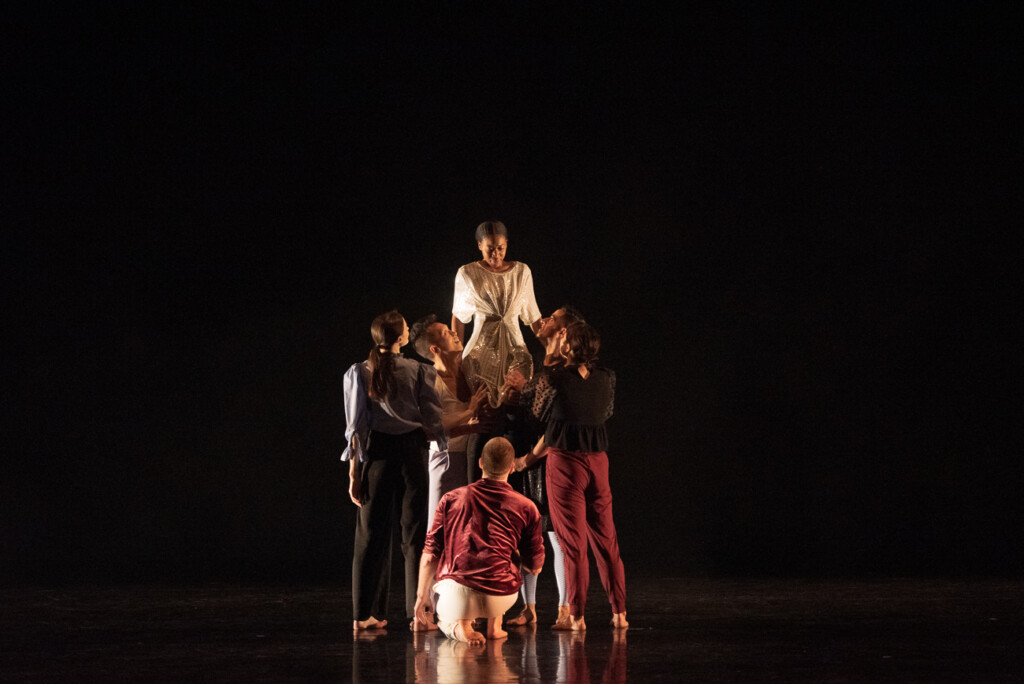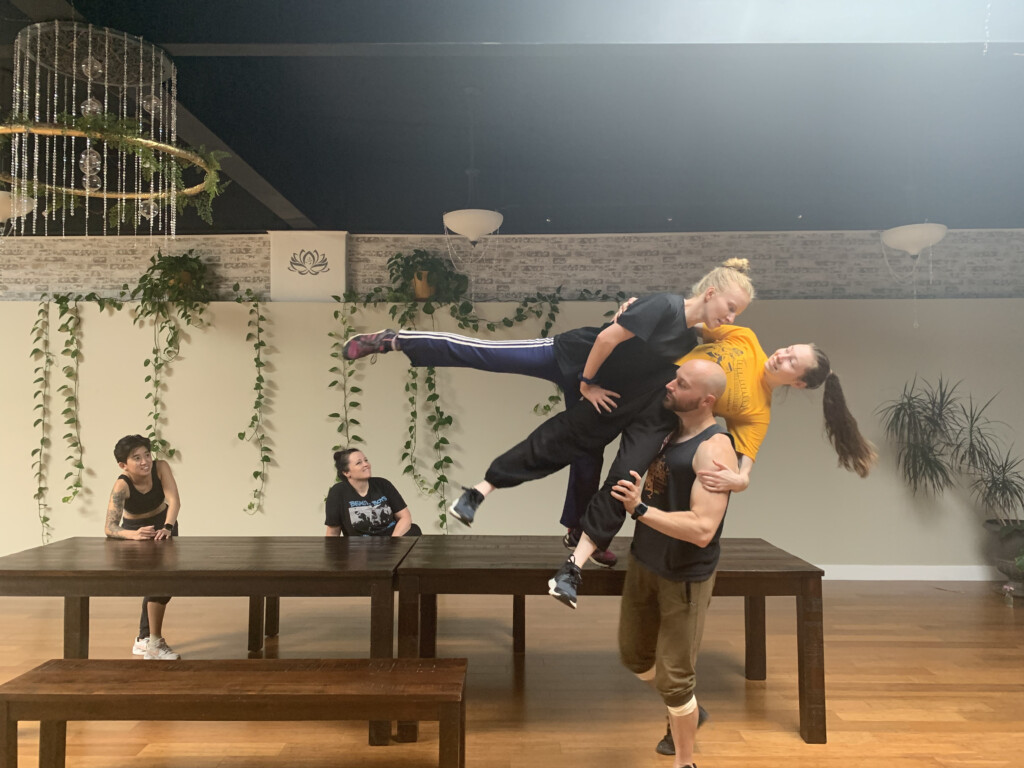With live performances resuming on several fronts, the arts calendar for the fall season in Salt Lake City has returned to levels not seen since the fall of 2019. The Utah Review offers reviews of three shows, seen within the span of four days.
RIRIE-WOODBURY DANCE COMPANY: TOTAL ELLIPSE
Season openers for Ririe-Woodbury Dance Company always put forth a cogent, intelligent theme for threading the works together in the first fall concert. To open its 58th season and its return to live stage performances after.a 20-month hiatus due to the pandemic, the company chose the most appropriate tone in its Total Ellipse theme.
Daniel Charon, the company’s artistic director, wrote in the concert playbill, “As we return, there is a tangible sense of re-appreciation for the art form and what is embedded within its DNA––connection, community, and an awareness of those around us. I hope that this performance can offer a sense of solace, an opportunity to reflect, and moments for your imagination to feel free.”
All three objectives that Charon cited were met with immensely gratifying results in the 75-minute program that brought two world premieres and the return of a commissioned work which premiered four years ago.
The opener was pitch perfect: Charon’s On Being, a work of pure natural energy that introduced audiences to the company’s six dance artists, including five of whom either are in their first or in their second season. It was a marvelous introduction to a company, which represents a new generation in bringing contemporary dance to Salt Lake City audiences.
Charon has a gift for setting movement that elicits distinctive personality traits of the artists and the dancers visibly were delighted as they gave artistic justice to an elegantly choreographed statement on the theme of solace. There were moments of remembrance but also joy in the return to unrestrained movement, where partnering once again seems natural. On Being offers a well-earned respite from the emotionally taxing prolonged period that all of us have endured since the early spring of 2020. Charon chose appropriately the source of the work’s music — Eydís Evensen, a contemporary Icelandic composer. Evensen’s music parallels the authentic live-life-to-its-fullest sentiment inherent in the dance movement. The rhythm pulsates without interruption even as both music and movement evoke ongoing shifts in the spectrum of emotion, emphasizing that it is okay to be vulnerable and even pause briefly to reflect on the challenging burdens all of us have had to bear recently.
The other premiere, a commission titled Two Hearted, introduced audiences to Keerati Jinakunwiphat, a young Thai-American choreographer who dances with Kyle Abraham’s A.I.M and continues to develop along a rapid trajectory since she graduated from SUNY-Purchase five years ago. Two Hearted signals the immense creative possibilities in a new generation of contemporary dance, introducing a bracing, ingenious take on a theme that has been explored by numerous choreographers in various forms. In her exploration of the value of clear hindsight in reflecting upon the successes and failures of relationships, Jinakunwiphat mixes it up fabulously, taking the cues of Bryndon Cook’s musical score to set movement that is as lush, silky and smooth in its R&B manifestations as it is athletic and agile in its street-inspired character.
JInakupwiphat has studied with Doug Varone, a choreographer who has several works in Ririe-Woodbury’s repertoire. And, there is evidence of the creative ‘family tree’ influence. For example, Varone’s Strict Love (1994), inspired by songs that would have been the top hits of the early 1970s, conjured memories of television shows American Bandstand and Soul Train, when these songs would have been featured while dancers (professional and amateur) moved on the set. The eccentric and idiosyncratic dance moves in Varone’s work underscored just how the desire for self-expression overpowered the barriers that excluded some from the community. JInakupwiphat advances this precise timeless dynamic superbly in Two Hearted, introducing artists and audiences to new gestures, sounds and interactions that enrich movement vocabularies and languages.
The concert closed with Raja Feather Kelly’s Pantheon, a commission that opened the 54th season four years ago. Megan McCarthy was the only Ririe-Woodbury dance artist who performed in the premiere so it was fascinating to see how the five newcomers to the piece — Peter Farrow, Alexander Pham, Miche’ Smith, Corinne Lohner and Fausto Rivera — absorbed the task of bringing anew Kelly’s artistic expression back to the Rose Wagner Center for Performing Arts stage.
Kelly’s work is as relentlessly demanding in its athleticism as Jinakupwiphat’s Two Hearted but the company’s stamina was unquestionably operating in full steam ahead mode. Compared to the 2017 performance, this latest rendering sharpened the takeaway from Kelly’s work. The key problem question Pantheon deals with is what should we make of our current pop cultural obsession with celebrities and the inevitable loss of control that comes with fame and the unrelenting demand of a consumer market? The work opens with the dancers clad in wigs, white briefs and bras, gym socks and tennis shoes and one by one, the dancers put on silk jumpers.
Peppered with voiceover narration at several points, the work, with original music by Sam Crawford that is inspired by pop and electronica and is primal in its dance club sensibilities, appears as an ideal companion to Two Hearted. The company’s dance artists seemed completely comfortable in the essence of Kelly’s creation, particularly as the entirety of their lives has encompassed virtually all of the pop cultural references and social influences that appear in Pantheon.
ROGER BENINGTON: PSYCHOPOMP
A creative anchor for many of Salt Lake City’s independent theatrical companies, two-hander plays have produced some of the most substantial examples of the Utah Enlightenment’s power of social expression. No question, Roger Benington’s Psychopomp deserves a place in this canon.
The 2017 play received its U.S. premiere this month in Salt Lake City, with Paul Kiernan in the role of a Mormon father whose personal and economic fortunes have collapsed. Kiernan is joined by Tyler Fox, who takes on the role of a son whose own troubles point to a deadend that he sees as inescapable. Both actors gave brilliant performances to a brilliant script.
Local theatergoers will remember Benington, who led Tooth & Nail Theatre for many years before moving to New York City. Building on the essential definition of psychopomps, who are tasked with guiding departed souls to their post-mortal destiny but do so without making final judgment, Benington framed the play within the political culture of resentment, ignored grievances and the dilution of privilege that catapulted Trump into the nation’s highest elected office. The script was commissioned in London for production, which premiered at the Canal Cafe Theatre.
Benington lays out a finely nuanced critique of Mormonism that navigates away from the doctrinal pillars, which formally bind the faith to its members. Instead, he zeroes in on the irreconcilable paradoxes of satisfying the cultural demands of perfectionism, which eclipse a sincere pursuit to accept the confessional premises of faith on its most basic spiritual expectations. Both father and son are so pained by the sting of their respective failings to achieve the idealized form of perfectionism that they become ever more endangered and vulnerable to the lure of shapeless, faithless excuses, which permit them to avoid a serious personal reckoning with their greatest shortcomings. Mormonism is no different than any other confessional faith in falling short to provide perfect answers to personal or spiritual crises or to soothe the pain of loss, disappointment and rejection. In Psychopomp, the multidimensional betrayal engulfs and blinds both of the characters, thereby shutting them off from attempting to find solace as a path toward a bittersweet, poignant sense of atonement. There is not a glint of optimism or probability that either father or son could find some modicum of peace in a life rendered so imperfectly.
The production’s unique staging electrifies the raw rage and frustration that percolates throughout the play. It is rightly discomfiting, even terrifying in several instances. Even a few fleeting injections of dark humor do not alleviate the tension. Likewise, a few bits of music, courtesy of The Carpenters, with Karen Carpenter’s legendary voice, actually intensify the tensions of contrasting sentiments.
The production is set in what was once the gym in a former Mormon chapel, now known as The Art Castle, owned and operated by Utah Arts Alliance. The space is surrounded by closets, which become critical elements in the play’s storyline. The audience was placed within inches of the action, most of it occurring within a small space that included a bed resembling a cot and a desk that is bare except for a lamp. The set is stark in how it evokes the failure of impoverishment, in economic and spiritual ways. Once entranced by the lifelong prospects of Mormon mission, marriage and mortgage culminating in a leisure-filled retirement, the father is reduced to barely hanging onto his job as a 7-11 cashier. The family is shattered. The son is homeless, purposeless and unable to process and cope with a personal tragedy. The play leads both characters to a conclusion that shocks and rattles. The script is unapologetically brutal in its candor. Its greatest literary strength comes through the layered metaphorical considerations of monsters and monstrosities.
Fox and Kiernan deliver performances that convince the viewer that they, indeed, could be father and son in real life. There is a lot in Psychopomp that hits right at home in Utah, where the efforts to succeed in an impossible-to-achieve culture of perfectionism has produced many disappointments, heartaches and some tragedies as catastrophic as those found in the play. Ambiguities, euphemisms or civility do not provide sufficient balm or salve to diminish the sting of emotional, spiritual and personal failures. Certainly, during one’s earthly existence, we might welcome a guide without judgment to help steer those who feel genuinely betrayed or resented into meaningful, sensitive discussions that provide at least a modicum of grace and solace to endure some of life’s most bitter disappointments.
SONDERIMMERSIVE: THE CHOCOLATIER
One of SONDERimmersive’s most artistically successful shows, The Chocolatier, returns to live performances after being abruptly shut down 19 months ago after a weekend of previews, due to the pandemic.
The latest version, the show’s third, is now available but with a different cast, some expanded scenes and new content, and is offered in a new location: the Lila Yoga Studio in the Sugar House neighborhood of Salt Lake City. The first version, which premiered in late 2019, was Thank You, Theobromine. Set in The Chocolate Conspiracy shop, near the corner of 800 South and 300 West, the show immersed its audience members, who always were kept on the move, in dramatic scenes incorporating dance, theater, music and samples of chocolate. In 2020, the show was set to return in its new form with a new title – The Chocolatier. Named as one of The Utah Review’s Top 10 Moments of the Utah Enlightenment in 2020, the retooling succeeded, retaining all of its original fascinating, enigmatic appeal while opening the door wider for audience members (and chocolate consumers) to appreciate a craft where merely explaining or observing the technique and science hardly does justice to the magnificent, passionate, hard-won stories behind its creations. With a cast of seven actors, The Chocolatier amplified dramatically the eco-conscious, methodical, even soft-spoken actualities of the shop’s founder, A. J. Wentworth.
That second version never formally opened but the creative team led by Graham Brown have used the intervening year and a half to create the third version. But, the results of this latest retooling do not rise to the unquestionably stronger second version, which, in retrospect, should have been given its fair due in public performances.
This is not to challenge the wisdom of restaging a show, an acceptable practice that can ensure a show’s organic character is sufficiently refreshed. No question. The Chocolatier is an unconventional immersive theatrical experience that stands out because of its possibilities to give a unique experience to each theatergoer, whether they are seeing the show the first, second, third, fourth or even fifth time. The show’s broadest format remains the same: strictly limited to a small maximum number of audience members per performance, who gather in the studio’s front space. Audience members select their experience, as based on the characters of the five groups – The Hero (Emma Sargent), The Rejector (Edison Corvera), The Altruist (Severin Sargent-Catterton), The Libra (Chris DelPorto) and The Divine (Danell Hathaway). Rounding out the cast are Grandpa Joe (Jack Foriska) and Sport (Kai Jones). Once the audience enters the show, various actors swarm upon individuals, whisking them away or directing them to a specified location. From that point, each member of the audience is destined for their unique experience. As in previous versions, no one ever experiences all of the possible scenes that encompass The Chocolatier in one performance or the full spectrum of each character.
Granted, the show’s individualized experience stresses that no one person will see the whole spectrum of characters, stories, scenes, events, etc. But, this latest version lacks the right rhythmic pulse for the sake of coherence and continuity and leaves too many spaces where audience members could have at least enough details or foreshadowing to fill in the blanks involving characters. In the original version of the show, this critic experienced it via The Hero group. In the second version, it was the Divine group. In this latest version, the critic chose the Divine group again but while the Divine character is not intended to encompass the holistic genius of the chocolatier there also was a flatness in emotion and lack of passion, which was not a problem in the second version. From that point, the show, excessively long at approximately one hour 45 minutes, faltered in momentum repeatedly with scenes that should have been edited considerably. Likewise, the wonderful emotional nature that made The Grandfather and Sport sparkle in the second version were missing in this latest version.
After seeing two versions of the show in The Chocolate Conspiracy’s shop, the 800 South 300 West location which is no longer available as Wentworth has moved his business westward in the city to 3565 Harvey Milk Boulevard, it was more difficult to grasp a sense of the potential flow of the immersive experience in the yoga studio’s spaces. Partly, the old shop’s style and character suited the mood and tone of the two versions of the show. It is difficult to transfer that mood in the Sugar House location because of its layout.
The Chocolatier stands out as one of SONDERimmersive’s most successful artistic creations and perhaps the latest version will eventually take hold as performers adjust to the space and the flow of the theatrical experience.
The creative team includes members from the original version along with newcomers as well as cast members. Graham Brown leads the creative team for the latest iteration. Writers include playwright and Sackerson producer Morag Shepherd, along with Brown, Mara Lefler, Michael Watkiss — who works at the shop with Wentworth as a chocolatier — and Molly Chrisman), scenography by Joe Wheeler (assisted by other production team members) and composer Nick Foster, who also is a member of the Salt Lake Electric Ensemble. Joining Wentworth on the team is Chanda Way, Lila Studio keeper.
Tickets are available for performances on Fridays, Saturdays and Sundays during most weekends in October. For more information, see the SONDERimmersive website.







